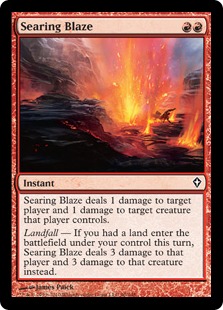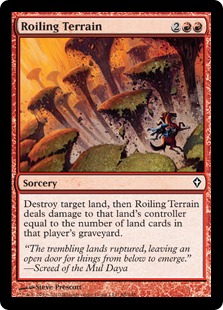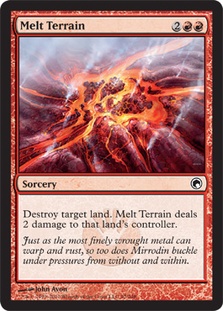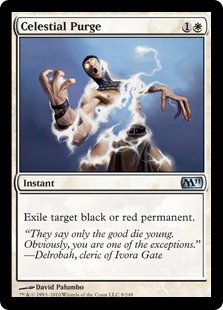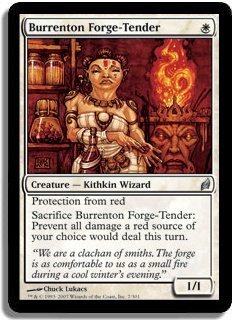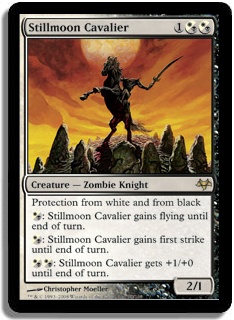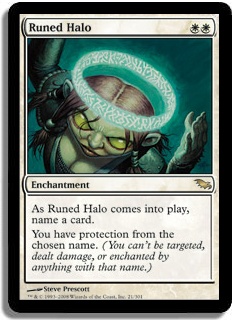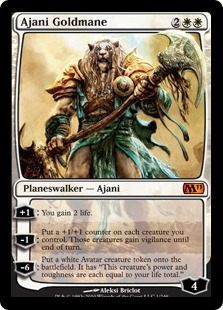We’re at a conflux of formats the likes of which rarely has been seen. On one hand, the mighty armies of Wizards of the Coast offer riches, glory, and countless similar “bad beats” stories on the PTQ circuit. On the other hand, those stealthy rogues at StarCityGames.com (SCG) have managed to make Standard a relevant format all year!
As Constructed players, we’re caught in a ravine between the old (Standard) and the new (Extended) — and those of us who are ambitious will pursue success in both formats with fervor. Let’s take a moment to find our bearings in both formats.
Something Old
— Standard! This format has become… well… standard. With the SCG Invitational and Worlds providing decklists from the best minds around, it doesn’t feel like there’s a lot of room for innovation. At the same time, it’s 2011, and SCG has an Open Series that seems like a much more accessible Pro Tour! Standard is now a relevant format for more than two months out of the year.
Maybe it’s time for us to revisit ideas that were discarded in the past but that might, with a few key changes, become competitive once again.
Something New
— Extended!
This is a deceptively fun format.
At first, trying to playtest Extended in preparation for the PTQ season was like entering
a parallel universe where Jigsaw from the
Saw
franchise had redirected his sadistic efforts toward Magic players.
Everything we’ve done wrong in the last several years of Standard has come back to haunt us.
: You want the key to that wooden jawbreaker thingy? It’s right over there! All you have to do is cascade a Bloodbraid Elf into a Blightning, cast Mistblind Clique on your opponent’s upkeep, and trigger Valakut twelve times.
: NO! I won’t do it! I’m still a human being, damnit!
We can survive our recurring nightmare, though, through judicious application of a few clichés:
“Things always seem darkest before the dawn…”
Durr…
“There are other fish in the sea…”
Uhh…
These clichés — straight from the book
Mom’s Dating Advice for Sad Kids
— are very apt for Extended circa 2011. These old Standard decks aren’t all there is.
This is a format ripe for the breaking — with so many cards available to us,
this format shouldn’t feel like “Build Your Own Standard”
— there surely are viable decks that attack this metagame in ways that we haven’t yet anticipated. The key is to find them.
Let’s begin with “Something Old” — a blast from the past for Standard. Afterwards, we’ll move to something new — strategizing for Extended. And I promise: neither section will contain anything blue!
Something Old
Right now, Standard feels like an old movie.
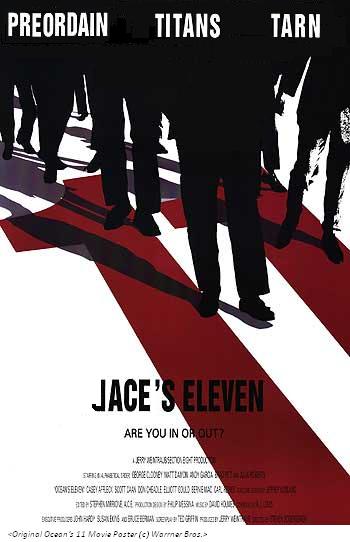
Prior to the SCG Open last weekend, it felt like no one was attacking in Standard. Sure, Gideon Jura attacks, and Primeval Titan attacks, but aggressive decks haven’t exactly been prevalent (with the exception of B/R Vampires). Any time these types of decks fall off of the radar, it’s an excellent time for us to surprise our opponents with some quick wins before they have time to regret taking those mass-removal spells out of their sideboards.
For the sake of full disclosure, I was going to write part of this article about how Boros has an unrecognized place in the metagame — and then, while I was in the middle of writing my article, Pat McGregor went and won the SCG Open in Kansas City with Boros (and with a list that literally is five cards different from mine, though his list seems more optimal).
Congrats Pat!
For reference, his list:
Creatures (22)
Planeswalkers (2)
Lands (25)
Spells (11)

The only maindeck difference between this list and the one that I was testing is that I ran a sixth Plains instead of an Evolving Wilds. I initially tried to run three ‘common fetchlands,’ but I encountered one too many situations where I needed several white mana (i.e. to play a slew of Squadron Hawk) and had one enter the battlefield tapped. It may seem that we’re focusing overmuch on minutiae here, but over the course of a large number of matches, it’s something that presents itself as frustrating.
The only other difference is that I had four Luminarch Ascensions in the sideboard over two Arc Trails, one Cunning Sparkmage, and one Tectonic Edge.
This sacrifices a slight advantage against ramp decks (the Tectonic Edge, which presumably was used against U/x Control as well) and aggressive decks (loss of Arc Trail and one Cunning Sparkmage) to provide a trump card against U/B and U/W Control. Sure, these decks have Ratchet Bomb, but it rarely appears in large quantities, and sometimes we’ll just lucksack and win the game on turn 2.
I’ve still included the results of my online tournament activity with the deck, but I guess that cat’s out of the bag, and, like an uncle of mine once said, “It ain’t going back until you lose your nose to those claws.”
Actually, I never had an uncle who said that, but doesn’t it seem like it could be some folksy wisdom?
I played in eighteen matches in “gold” 2-man queues, Daily Events, and a few regular 2-man queues, with these results:
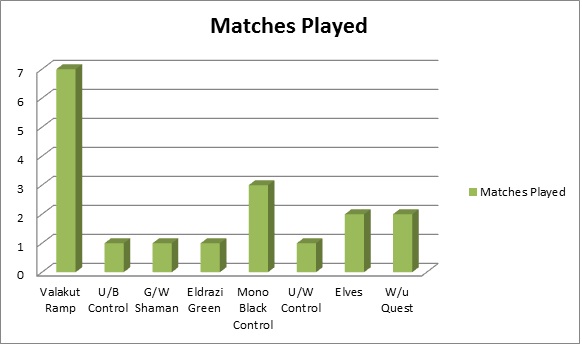
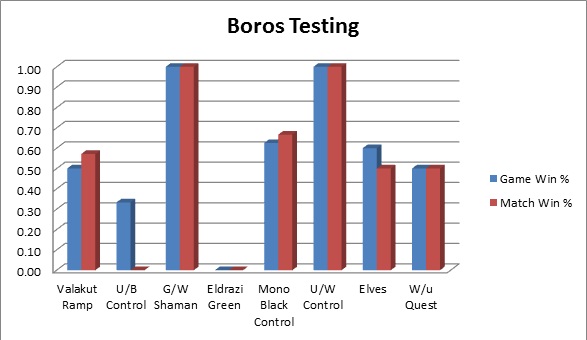
My overall
game
win percentage was 55%, and my overall
match
win percentage was 56%. These numbers don’t mean a lot, honestly (this is a small sample size), but they provide a very brief, initial picture of how Boros might operate in an online metagame.
Obviously, the deck also can win a SCG Open,
so that’s enough about that.
Red-based aggro once again feels valid in Standard!
Interestingly, though, one of the weaknesses that I observed when I played Boros was the Valakut Ramp and Eldrazi Green decks running Tumble Magnet.
While we intuitively understand that Boros is a very fast deck, its speed often is derived from one or two highly powerful creatures that have multiple landfall triggers or pump effects from Adventuring Gear and Sword of Body and Mind. Very often, we need to invest our resources in one or two creatures prior to entering our “declare attackers” step, meaning that a Tumble Magnet seriously can impede our progress.
We might encounter a similar problem when playing against decks like U/B Control, where a well-timed Doom Blade or even Into the Roil can be disastrous.
How can we seek to play aggressive, red-based decks in Standard without succumbing to this vulnerability? We might return to a deck that most of us have dismissed as being “bad.”
One of the most “under-the-radar” decks at the moment… is Kuldotha Red.
“Is that even a deck?”
The most high-profile finish that the deck has seen recently is a finish at the SCG Invitational in December, where David Mayer took twelfth place with
this list.
We should ask, though, whether its absence of finishes is because people are playing the list and failing, or because it’s been discarded, even from playtesting groups, as a flash-in-the-pan gimmick.
Like
Mythbusters,
but with 100% fewer awesome hats, bald heads, giant mustaches, and overarching auras of machismo, let’s find out.
Using Mayer’s version of the deck as a starting point, I played twenty tournament matches on Magic Online in “gold” 2-man tournaments, Daily Events, and regular 2-man tournaments.
Like the Magic player
who famously ate a Jace, the Mind Sculptor,
you might say…
I put my money…
Where my mouth is.
YEAAAAAAAAAAH.
In the end, this was the list that emerged, sweaty and beaten, from the laggy crucible:
Creatures (19)
Planeswalkers (3)
Lands (23)
Spells (15)
Sideboard

This list looks outwardly similar to existing Kuldotha Red lists, but I think that the proposed changes are important if we want to succeed with the deck.
So how did we get from Point A to Point B? Let’s begin with some results. Although I played against a disproportionate number of B/R Vampires decks, I got a pretty good view of the field in those twenty matches (I have reported data for seventeen because three of them were ‘outlier’ matches — i.e. I mulliganed to three, or my opponent did, etc.).
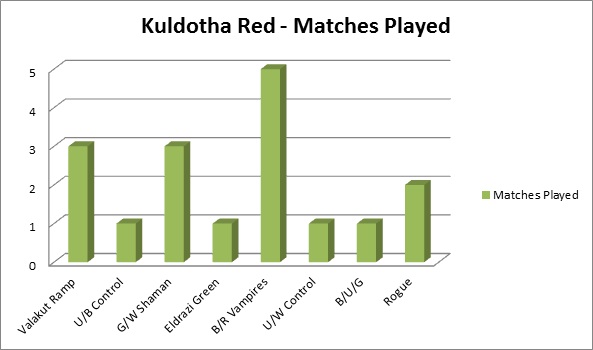
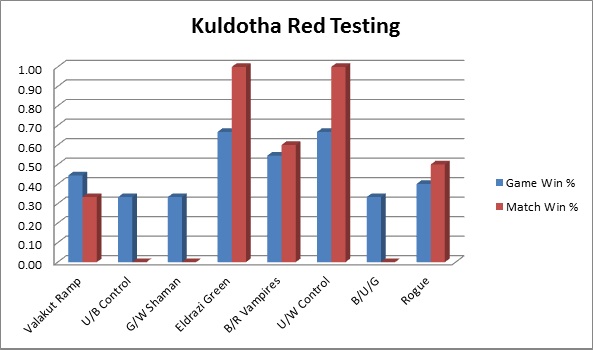
My overall
game
win percentage was 46%, and my overall
match
win percentage was 42%. It’s also worth noting that these results
don’t accurately represent the list that I recommend
because as I played through matches, I continuously was modifying the deck.
It also is worth noting that almost every game that I played was “close.” There were games that I would’ve won had I played around a single card differently (hello, singleton Platinum Angel out of the board), and there were games that I would’ve lost had I not had the
third
Goblin Chieftain. These percentages shouldn’t be taken to suggest that this is “how the deck performs.” In other words, I don’t think that Kuldotha Red is 42% against the field, nor do I think that it has a 0% matchup against U/B Control (far from it, when I’ve played against it in the Tournament Practice room, I’ve done very well against it but foolishly didn’t track my performance). I simply have provided the numbers for the purpose of transparency, so that when we begin to discuss changes to the deck, we’re all on the same page.
The Core of the Deck:
There’s not a lot of room for ‘innovation’ in the main deck. The deck’s core strategy relies on Goblin-based synergies (and we’re certainly not going to cut Lightning Bolt), leaving us with a relatively hefty shell on which to build.
4 Goblin Bushwhacker
4 Goblin Guide
4 Goblin Chieftain
3 Spikeshot Goblin
4 Kuldotha Rebirth
4 Lightning Bolt
The Artifacts:
Different versions of this deck run between eleven and fifteen artifacts costing between zero and one mana (with the occasional addition of Perilous Myr).
The following artifacts provide what seems to be optimal utility for the deck.
Chimeric Mass — I prefer this card to Mox Opal or to various pieces of equipment in almost every circumstance because it’s never a “dead draw.” It either comes down for ‘0′ and fuels a Kuldotha Rebirth, or it plays the role of Leonidas, pushing your little green Spartans forward to attack through a Primeval Titan.
Memnite — We probably shouldn’t cut Memnite from the deck for any reason.
Panic Spellbomb — Probably the best one-cost artifact for the deck due to the cycling ability; further, the unblockability effect often acts as an additional burn spell.
The Other Major Change:
When developing this newer decklist, we added four lands (two Teetering Peaks and two Mountain) in addition to three Koths of the Hammer at a loss of cards like Arc Trail.
Why might we consider such a change?
Cards like Arc Trail are very good against decks like B/R Vampires (which isn’t a bad matchup even without additional removal in the main deck), and sometimes we’ll live the dream and kill an Oracle of Mul Daya and Lotus Cobra with the same spell on turn 3. That having been said, there are so many matchups where the card is no more than a Shock for two mana. Additionally, the number of aggressive decks being played in major tournaments dramatically has fallen, and R/U/G (with the oh-so-tempting-to-burn Lotus Cobra/Oracle pairing) is no longer the golden child of Standard.
Decks like Valakut Ramp, U/B Control, and U/W Control feature board-sweepers, and since the majority of our plan is “all-in” aggressive draws, being unable to play a turn 3 Goblin Chieftain potentially is fatal. As such, the calculated risk of running fewer lands to maximize the number of cards we can draw that deal damage doesn’t seem to produce as much utility as running a larger number of lands (two of which can produce damage themselves). In addition, resolving a Koth of the Hammer against U/B or U/W Control places their pilots in a very difficult place because they presumably have to answer both your planeswalker and the suite of creatures that you played in earlier turns.
The Sideboard:
What else can we add to the sideboard to push this deck into viability? There are three cards in particular that the ‘current’ iterations of the deck aren’t running that we might find useful. First, though, we need to remove those cards that have less utility.
Many versions of Kuldotha Red incorporate cards like Perilous Myr to combat Kor Firewalker, but as red decks fall further and further from the Standard radar, cards like Kor Firewalker are less necessary, reducing our need to run Limited cards like Perilous Myr, which don’t perform an important function against most other decks.
These same decks typically feature additional copies of Arc Trail to combat aggressive decks.
If we really want to attack other aggressive decks, though, we should focus on creatures that might provide problems for us, many of which have three toughness. These cards include Vampire Nighthawk, Vengevine, and Kor Skyfisher, all of which irritatingly and easily can derail our plans.
Vampire Nighthawk, in particular, appeared in the sideboard of all five B/R Vampire lists against which I played, and it’s on an
entirely new plane of frustrating.
I didn’t get any sleep because of it.
Therefore, it won’t get any sleep because of me.
Enter Searing Blaze.
We should acknowledge, though, that to the extent that other red decks and Boros become more popular (which they very well may), we carefully should consider whether Arc Trail should return to the sideboard.
Moving on…
Let’s look at those seven land-destruction spells.
U/B Control established a true foothold in the metagame when it took the top two slots at Worlds 2010. It’s resilient, makes excellent use of Jace, and doesn’t really have a problem killing creatures. It even has Creeping Tar Pit to kill Koth of the Hammer. It has a significant weakness, though, in the cost of its threats.
I’ve never been exposed to quite as much vitriol and hatred on Magic Online as I have when I’ve beaten opponents with these two cards. One U/W Control opponent, for example, was on the draw and played Wall of Omens into Jace, opting to draw a card. I simply untapped and played Melt Terrain on his Celestial Colonnade, redirecting the damage to Jace.
*Disconnect*
I actually burned out a U/B player with successive land destruction spells after he kept a hand full of creature removal like Consume the Meek and Doom Blade.
This isn’t a strategy that works well in versions of Kuldotha Red that run only nineteen or twenty lands, but since we’ve opted to increase our land count, it’s a very viable strategy to attack some of the stronger decks in the metagame from a different angle while controlling their ability to play larger threats to compete with our Goblins.
As a side note, I’m not entirely sure that Goblin Ruinblaster doesn’t have a place in one of these two slots. On one hand, it doesn’t have as much utility in terms of its ability to kill planeswalkers through creature removal, but, on the other hand, it benefits from the ‘pump’ effects of Goblin Chieftain and Goblin Bushwhacker.
This is a question that those of us who continue to tinker with the deck should seek an answer to.
If we want to isolate one lesson from “Something Old,” it should be that attacking is not a dead art form in Standard. Perhaps control players have become complacent — where are those Kor Firewalkers? Where are those Days of Judgment? These upcoming weeks are an excellent time for those of us who like to
attack
to exploit our collective community’s short memories and to swing into the red zone.
Something New
Right now, Extended reminds me of Jack Black in
The Pick of Destiny.
We have reunited ourselves with Sasquatch
(all the old archetypes). We’re cheerfully swimming down a strawberry river, complacent with ‘the way things are’ (also happy to have ridden on a Bigfoot), and suddenly the magic mushrooms wear off, and we realize that we’re in deeper water than we imagined.
What at first seems like a mélange of Faeries, Jund, and Wargate quickly reveals itself to be a very wide-open format.
Let’s look at the results from the first three Extended PTQs. I’ve weighted the results so that every appearance in the Top 8 is worth three points, and every time a deck achieves ninth through sixteenth place, it receives one point.
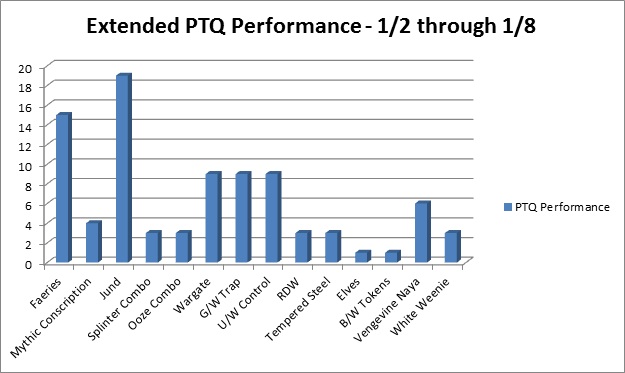
These numbers don’t fully capture the extent to which decks are being played in PTQ-level tournaments, but they do indicate, to some extent, the relative level of success that decks currently are experiencing. Sequentially, the top 5 decks are:
1)Â Â Â Jund (19 points)
2)Â Â Â Faeries (15 points)
3)Â Â Â Wargate (9 points)
G/W Trap (9 points)
U/W Control (9 points)
If we look back to the results of Pro Tour Amsterdam, though, this should seem strange. There’s only one appearance for White Weenie, which won the Pro Tour. Has the format changed so much?
Avantasian doesn’t seem to think so, and he took the deck to a Top 8 performance at a Magic Online PTQ (January 7).
Creatures (21)
- 3 Figure of Destiny
- 4 Ethersworn Canonist
- 4 Knight of the White Orchid
- 2 Ranger of Eos
- 4 Steppe Lynx
- 4 Student of Warfare
Lands (23)
- 15 Plains
- 4 Arid Mesa
- 4 Marsh Flats
Spells (16)

His list is similar to the lists that performed well at the Pro Tour, except that he doesn’t have Mana Tithe available to him (which generally didn’t appear in quantities greater than two). Interestingly, in a section focusing on a ‘new’ format, we find ourselves returning to examine
older
strategies.
This is a strategy that I considered during the holidays, and, while traveling, I didn’t always have access to Magic Online, and so I was able to work with this deck using paper cards.
My experiences with the deck suggest that there are several cards that should be reexamined if we want to play this deck.
Celestial Purge — This card appears as a three-of in the most recent list, but it may actually merit a fourth copy. Here’s a brief list of cards in top-tier decks that Celestial Purge answers:
Bitterblossom
Creeping Tar Pit
Bloodbraid Elf
Boggart Ram-Gang
Figure of Destiny
Raging Ravine
Demigod of Revenge
Putrid Leech
Necrotic Ooze
Every creature in RDW
Forge[/author]-Tender”]Burrenton [author name="Forge"]Forge[/author]-Tender — In the abstract, Kor Firewalker seems like a better card; gaining life from every red spell that our opponent plays generally will add up to more utility than preventing the damage from one source. However, since we have Ranger of Eos in our deck, the ability to tutor for one or two Forge[/author]-Tender”]Burrenton [author name="Forge"]Forge[/author]-Tenders can prove invaluable against red-based decks. As such, we should consider some sort of Kor Firewalker/Forge[/author]-Tender”]Burrenton [author name="Forge"]Forge[/author]-Tender split in sideboards.
Stillmoon Cavalier — I played this card for nearly a year in Standard Kithkin, and it was an excellent tool with which to fight Faeries, as it flies, can kill all of their creatures, and is immune to all of their removal (nice Peppersmoke!). It also is excellent against Jund because it dodges Maelstrom Pulse and can block cards like Putrid Leech and Demigod of Revenge with impunity. If White Weenie picks up in popularity, it will be an excellent tool for mirror matches.
Runed Halo — Leyline of Sanctity, which often occupies a slot in WW sideboards, is a very strong card against Wargate and other Valakut-based variants, but it seems as though Runed Halo does the same job while remaining relevant against other decks, especially the early-round control decks that are waiting to cast Cruel Ultimatum or similar cards.
Ajani Goldmane — Many of the successful decks in the format play a large number of creatures, and Ajani is an excellent tool with which to win the ‘creature war.’
How can we revise the current lists, then, to incorporate these ideas? We might try the following deck as a starting point.
Creatures (20)
- 4 Figure of Destiny
- 2 Stillmoon Cavalier
- 4 Ethersworn Canonist
- 3 Knight of the White Orchid
- 2 Ranger of Eos
- 2 Steppe Lynx
- 3 Student of Warfare
Planeswalkers (2)
Lands (23)
Spells (15)

Admittedly, this list doesn’t look as “tight” as previous lists, but this is where I currently am in the ‘testing’ process for Extended. I expect the format to shift dramatically before all is said and done, and White Weenie certainly is a deck that can change with the metagame to remain a contender.
If we want to isolate one lesson from “Something New,” it should be that, in the current Extended format, White Weenie has a very versatile set of tools with which it can attack almost any dominant archetype. If we closely examine our sideboard and maindeck options, we continuously can revise the deck so that it can remain a contender.

